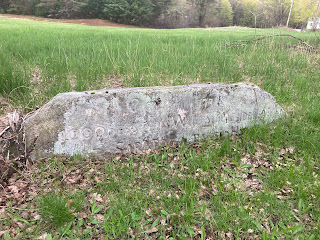How Many Routes Were There - "I Divided Them Into Two Divisions"
My first impression after reading Massachusetts Militia Private David How's diary, and British Ensign Thomas Anbury's Travels Through the Interior Parts of America was that in 1777 the Convention Army had marched as a whole from Saratoga, New York, through the southeast corner of Vermont and across Massachusetts to Cambridge.
Early on in my research I encountered evidence that the British and German troops who surrendered at Saratoga followed two routes into central Massachusetts, and a common route on to confinement in Cambridge and on Winter and Prospect Hills. Brigadier-General John Glover, assigned by Major-General Horatio Gates to supervise the march, clearly states in his letter dated October 22, 1777, that he had split his prisoners into two columns, and "... sent on one Division of the prisoners, Consisting of 2,442 British troops, by Northampton, the other by way of Springfield, Consisting of 2,198 foreign troops. ... I have endeavoured to collect Provisions to serve them to Worster [Worcester, Massachusetts]; you will Please to order on Some to meet me at that place." [1]
I also encountered claims that the Convention Army took one route, three routes, and four routes in 1777. Some elements supposedly headed east from Saratoga through Vermont, then south along the Connecticut River; others south from Saratoga into western Massachusetts, then down into Connecticut before coming back into Massachusetts. Each of these claims is suspect.Another object on the same website, a powder horn said to belong to "... a Hessian in General Burgoyne's army" includes a reference to two British and two German routes: "There were several paths of march taken by the prisoners from the Saratoga battlefield to Boston following General Burgoyne’s surrender on Oct. 17, 1777. One march led by General James Brickett did pass through Hatfield and another passed through Northampton. These, however, were thought to consist of British soldiers. The Hessians were marched via more southerly routes through Springfield and Connecticut." There is no source cited for these claims either, or an explanation as to why there is a monument to the "Hessians" on one of the alleged northern routes, if the Germans traveled on two routes through southern Massachusetts and Connecticut in 1777.
An editor's footnote to the transcription of British Lieutenant (Lord) Francis Napier of the 31st Regiment of Foot's Journal indicates that it was just British prisoners who followed two routes, one through northern Massachusetts, the other through the central part of the state, while the Germans traveled through southern Massachusetts. The footnote cites a secondary source, William Dabney's After Saratoga, The Story of the Convention Army, as its source for this information. [2]
A 1907 article written for Political Science Quarterly suggests the Convention Army traveled on just one route, heading east first through Vermont, then south along the Connection River Valley to Hatfield. "Meanwhile the 'convention troops,' on the day after the formal exchange of the articles of convention, had begun their march toward Boston - over the Green Mountains from Saratoga to the Connecticut valley, down the valley through the historic towns of Northfield , Deerfield and Hatfield , then east across the river and through Hadley, Amherst and Worcester to Cambridge." There is no source for this claim either. [3] The Friends of Albany History website also has the Convention Army following one route, but "... south to Kinderhook, [New York] bypassing Albany, and then east to Massachusetts."
American Lieutenant Samuel Armstrong wrote in his diary that the British prisoners first went to Bennington. Armstrong however wasn't in Saratoga for the surrender or the start of the march. Ill, he had traveled south along the Hudson River to Lansingburg on October 16th, and remained there until November 1st. [4]
Given the lack of primary sources to support a third route (or only one route, or a fourth route...), I'd pretty much concluded others had mistaken the transport of prisoners taken in August at the Battle of Bennington or September in Colonel Brown's Raid on Fort Ticonderoga for the march of the Convention Army - and then I looked at Ensign Anburey's book again.Like other things with Anburey, the use of the map that accompanies his work requires caution. Nothing in Anburey's own account suggests he traveled along the route pictured. Rather, he specifies that after spending two days crossing the Green Mountains "... the first township we came to was Williamstown [Massachusetts]." [5] Later writers may have relied on this map to conclude the Convention Army traveled through Vermont and down the Connecticut River. To date though, no primary source accounts I've read support this conclusion. The map is also suspect in that just east of Worcester it shows the Convention Army traveling slightly northeast to Westborough, then southeast to Marlborough. While part of the British element of the Convention Army appears to have split off from the main route in Shrewsbury or Northborough, and traveled through Westborough, that would have taken them south of Marlborough, rather than north as shown on the Anburey map. (Note that the route marked to Rutland, Massachusetts, represents the moving of British prisoners to that town in 1778, rather than the route of march in 1777.)
Perhaps the best confirmation that there were two routes is General Glover's January, 24, 1778, letter to Major-General and Commander-In-Chief George Washington. Writing to Washington two months after the Convention Army had arrived in Cambridge and Charlestown, Glover shared with Washington that "... for the better supplying of which & the conveniency of the Inhabitants of the country through which they marched, I divided them into two Divisions; the British by Williamstown and Northampton; the Germans by Kinderhook and Springfield..." [6] Glover would know as well as anyone how the Convention Army marched from Saratoga to Cambridge in 1777.





Comments
Post a Comment